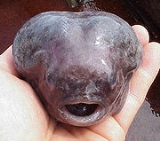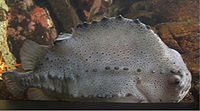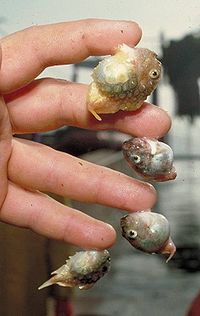
Lumpsucker
Encyclopedia
Lumpsuckers or lumpfish are mostly small scorpaeniform marine fish
of the family
Cyclopteridae. They are found in the cold waters of the Arctic
, North Atlantic
, and North Pacific
oceans. The greatest number of species are found in the North Pacific.
The roe
of Cyclopterus lumpus, known as the stenbider (literally "stone biter") in Danish
or stenbit in Swedish
, is used extensively in Scandinavian cuisine. The roe
is also used as an affordable alternative to the caviar
produced by sturgeons.
The family name Cyclopteridae derives from the Greek
words κύκλος (kyklos), meaning "circle", and πτέρυξ (pteryx), meaning "wing" or "fin", in reference to the circle-shaped pectoral fins of most of the fish that comprise this family.
 Lumpsuckers are named appropriately enough; their portly bodies are nearly spherical with generally drab coloration and lithic patterns. The "sucker" part refers to the fish's adhesive
Lumpsuckers are named appropriately enough; their portly bodies are nearly spherical with generally drab coloration and lithic patterns. The "sucker" part refers to the fish's adhesive
discs, located ventrally, behind the pectoral fins; the fish use these discs to adhere to the substrate
. Many species have bony, wart-like tubercle
s adorning the head and body; these are important taxonomic
features of the family.
The simple, rounded fins are small with the exception of the broad, fan-like pectorals, which actually extend ventrally. The first of the two dorsal fin
s is spinous, with 4-8 spines; in some species, this fin is completely overgrown with skin and therefore not visible. While the lateral line
in lumpsuckers is otherwise reduced or absent, it is well developed in the head; some species even have tubular, whisker-like external projections of the opercular canal, which is a part of the cranial lateral line system.
The relatively small mouths of lumpsuckers are lined with narrow rows of small conical
teeth. The gas bladder
is absent. In terms of length, lumpsuckers range in size from two centimetres in the case of Lethotremus awae up to 50 centimetres in the case of the common lumpsucker Cyclopterus lumpus.

; that is, they spend most of their time on or near the bottom. The fish are found on rocky or muddy substrates, where their coloration allows for effective camouflage
. Members of the family are found primarily on the continental shelf
or slope, at depths from 100-1,700 metres. Some of the deeper-living species are however pelagic
, remaining some distance above the ocean floor.
Benthic species feed on sessile
invertebrate
s such as polychaete
worms, crustacean
s and mollusks. Pelagic species target prey they are capable of overtaking, namely slow-moving jellyfish
and ctenophore
s.
in shallow, intertidal waters
(from December to June in the smooth lumpsucker); this may well be true of all species. Males are also known to guard the brood of spherical eggs.
One of the peculiarities of Lumpsuckers neural system is that they lack Mauthner cell
neurons in their hindbrain, while these cells are present in virtually all other teleost fish. Nevertheless, the lumpsuckers do have a C-startle response, which is apparently mediated by other hindbrain cells.
Hatchlings have well-developed pectoral fins and adhesive pelvic discs, which the fish use to cling to rocks in shallow water. Young fish remain in shallow, warmer water until fully developed. Pacific cod
and sablefish
are known predators of lumpsuckers.
 There are 27 species in 6 genera:
There are 27 species in 6 genera:
Note: Eumicrotremus eggvinii (Koefoed, 1956) has been shown to be the male of the E. spinosus species.
Fish
Fish are a paraphyletic group of organisms that consist of all gill-bearing aquatic vertebrate animals that lack limbs with digits. Included in this definition are the living hagfish, lampreys, and cartilaginous and bony fish, as well as various extinct related groups...
of the family
Family (biology)
In biological classification, family is* a taxonomic rank. Other well-known ranks are life, domain, kingdom, phylum, class, order, genus, and species, with family fitting between order and genus. As for the other well-known ranks, there is the option of an immediately lower rank, indicated by the...
Cyclopteridae. They are found in the cold waters of the Arctic
Arctic Ocean
The Arctic Ocean, located in the Northern Hemisphere and mostly in the Arctic north polar region, is the smallest and shallowest of the world's five major oceanic divisions...
, North Atlantic
Atlantic Ocean
The Atlantic Ocean is the second-largest of the world's oceanic divisions. With a total area of about , it covers approximately 20% of the Earth's surface and about 26% of its water surface area...
, and North Pacific
Pacific Ocean
The Pacific Ocean is the largest of the Earth's oceanic divisions. It extends from the Arctic in the north to the Southern Ocean in the south, bounded by Asia and Australia in the west, and the Americas in the east.At 165.2 million square kilometres in area, this largest division of the World...
oceans. The greatest number of species are found in the North Pacific.
The roe
Roe
Roe or hard roe is the fully ripe internal egg masses in the ovaries, or the released external egg masses of fish and certain marine animals, such as shrimp, scallop and sea urchins...
of Cyclopterus lumpus, known as the stenbider (literally "stone biter") in Danish
Danish language
Danish is a North Germanic language spoken by around six million people, principally in the country of Denmark. It is also spoken by 50,000 Germans of Danish ethnicity in the northern parts of Schleswig-Holstein, Germany, where it holds the status of minority language...
or stenbit in Swedish
Swedish language
Swedish is a North Germanic language, spoken by approximately 10 million people, predominantly in Sweden and parts of Finland, especially along its coast and on the Åland islands. It is largely mutually intelligible with Norwegian and Danish...
, is used extensively in Scandinavian cuisine. The roe
Roe
Roe or hard roe is the fully ripe internal egg masses in the ovaries, or the released external egg masses of fish and certain marine animals, such as shrimp, scallop and sea urchins...
is also used as an affordable alternative to the caviar
Caviar
Caviar, sometimes called black caviar, is a luxury delicacy, consisting of processed, salted, non-fertilized sturgeon roe. The roe can be "fresh" or pasteurized, the latter having much less culinary and economic value....
produced by sturgeons.
The family name Cyclopteridae derives from the Greek
Greek language
Greek is an independent branch of the Indo-European family of languages. Native to the southern Balkans, it has the longest documented history of any Indo-European language, spanning 34 centuries of written records. Its writing system has been the Greek alphabet for the majority of its history;...
words κύκλος (kyklos), meaning "circle", and πτέρυξ (pteryx), meaning "wing" or "fin", in reference to the circle-shaped pectoral fins of most of the fish that comprise this family.
Physical description

Adhesive
An adhesive, or glue, is a mixture in a liquid or semi-liquid state that adheres or bonds items together. Adhesives may come from either natural or synthetic sources. The types of materials that can be bonded are vast but they are especially useful for bonding thin materials...
discs, located ventrally, behind the pectoral fins; the fish use these discs to adhere to the substrate
Substrate (biology)
In biology a substrate is the surface a plant or animal lives upon and grows on. A substrate can include biotic or abiotic materials and animals. For example, encrusting algae that lives on a rock can be substrate for another animal that lives on top of the algae. See also substrate .-External...
. Many species have bony, wart-like tubercle
Tubercle
A tubercle is generally a wart-like projection, but it has slightly different meaning depending on which family of plants or animals it is used to refer to....
s adorning the head and body; these are important taxonomic
Taxonomy
Taxonomy is the science of identifying and naming species, and arranging them into a classification. The field of taxonomy, sometimes referred to as "biological taxonomy", revolves around the description and use of taxonomic units, known as taxa...
features of the family.
The simple, rounded fins are small with the exception of the broad, fan-like pectorals, which actually extend ventrally. The first of the two dorsal fin
Dorsal fin
A dorsal fin is a fin located on the backs of various unrelated marine and freshwater vertebrates, including most fishes, marine mammals , and the ichthyosaurs...
s is spinous, with 4-8 spines; in some species, this fin is completely overgrown with skin and therefore not visible. While the lateral line
Lateral line
The lateral line is a sense organ in aquatic organisms , used to detect movement and vibration in the surrounding water. Lateral lines are usually visible as faint lines running lengthwise down each side, from the vicinity of the gill covers to the base of the tail...
in lumpsuckers is otherwise reduced or absent, it is well developed in the head; some species even have tubular, whisker-like external projections of the opercular canal, which is a part of the cranial lateral line system.
The relatively small mouths of lumpsuckers are lined with narrow rows of small conical
Cone (geometry)
A cone is an n-dimensional geometric shape that tapers smoothly from a base to a point called the apex or vertex. Formally, it is the solid figure formed by the locus of all straight line segments that join the apex to the base...
teeth. The gas bladder
Gas bladder
The swim bladder, gas bladder, fish maw or air bladder is an internal gas-filled organ that contributes to the ability of a fish to control its buoyancy, and thus to stay at the current water depth without having to waste energy in swimming...
is absent. In terms of length, lumpsuckers range in size from two centimetres in the case of Lethotremus awae up to 50 centimetres in the case of the common lumpsucker Cyclopterus lumpus.

Habitat and diet
As their appearance might suggest, lumpsuckers are poor swimmers. Most species are benthicBenthos
Benthos is the community of organisms which live on, in, or near the seabed, also known as the benthic zone. This community lives in or near marine sedimentary environments, from tidal pools along the foreshore, out to the continental shelf, and then down to the abyssal depths.Many organisms...
; that is, they spend most of their time on or near the bottom. The fish are found on rocky or muddy substrates, where their coloration allows for effective camouflage
Camouflage
Camouflage is a method of concealment that allows an otherwise visible animal, military vehicle, or other object to remain unnoticed, by blending with its environment. Examples include a leopard's spotted coat, the battledress of a modern soldier and a leaf-mimic butterfly...
. Members of the family are found primarily on the continental shelf
Continental shelf
The continental shelf is the extended perimeter of each continent and associated coastal plain. Much of the shelf was exposed during glacial periods, but is now submerged under relatively shallow seas and gulfs, and was similarly submerged during other interglacial periods. The continental margin,...
or slope, at depths from 100-1,700 metres. Some of the deeper-living species are however pelagic
Pelagic zone
Any water in a sea or lake that is not close to the bottom or near to the shore can be said to be in the pelagic zone. The word pelagic comes from the Greek πέλαγος or pélagos, which means "open sea". The pelagic zone can be thought of in terms of an imaginary cylinder or water column that goes...
, remaining some distance above the ocean floor.
Benthic species feed on sessile
Sessility (limnology)
In limnology, sessility is that quality of an organism which rests unsupported directly on a base, either attached or unattached to a substrate. It is a characteristic of vegetation which is anchored to the benthic environment. There are two families of sessile rotifers: Flosculariidae and...
invertebrate
Invertebrate
An invertebrate is an animal without a backbone. The group includes 97% of all animal species – all animals except those in the chordate subphylum Vertebrata .Invertebrates form a paraphyletic group...
s such as polychaete
Polychaete
The Polychaeta or polychaetes are a class of annelid worms, generally marine. Each body segment has a pair of fleshy protrusions called parapodia that bear many bristles, called chaetae, which are made of chitin. Indeed, polychaetes are sometimes referred to as bristle worms. More than 10,000...
worms, crustacean
Crustacean
Crustaceans form a very large group of arthropods, usually treated as a subphylum, which includes such familiar animals as crabs, lobsters, crayfish, shrimp, krill and barnacles. The 50,000 described species range in size from Stygotantulus stocki at , to the Japanese spider crab with a leg span...
s and mollusks. Pelagic species target prey they are capable of overtaking, namely slow-moving jellyfish
Jellyfish
Jellyfish are free-swimming members of the phylum Cnidaria. Medusa is another word for jellyfish, and refers to any free-swimming jellyfish stages in the phylum Cnidaria...
and ctenophore
Ctenophore
The Ctenophora are a phylum of animals that live in marine waters worldwide. Their most distinctive feature is the "combs", groups of cilia that they use for swimming, and they are the largest animals that swim by means of cilia – adults of various species range from a few millimeters to in size...
s.
Behaviour and reproduction
Lumpsuckers are a poorly studied group, with little known of their behaviour and biology. At least some species are known to travel great distances in order to spawnSpawn (biology)
Spawn refers to the eggs and sperm released or deposited, usually into water, by aquatic animals. As a verb, spawn refers to the process of releasing the eggs and sperm, also called spawning...
in shallow, intertidal waters
Tide pool
Tide pools are rocky pools by oceans that are filled with seawater. Many of these pools exist as separate entities only at low tide.Tide pools are habitats of uniquely adaptable animals that have engaged the special attention of naturalists and marine biologists, as well as philosophical...
(from December to June in the smooth lumpsucker); this may well be true of all species. Males are also known to guard the brood of spherical eggs.
One of the peculiarities of Lumpsuckers neural system is that they lack Mauthner cell
Mauthner cell
The Mauthner Cells are a pair of big and easily identifiable neurons located in the rhombomere 4 of the hindbrain in fish and amphibians that are responsible for a very fast escape reflex...
neurons in their hindbrain, while these cells are present in virtually all other teleost fish. Nevertheless, the lumpsuckers do have a C-startle response, which is apparently mediated by other hindbrain cells.
Hatchlings have well-developed pectoral fins and adhesive pelvic discs, which the fish use to cling to rocks in shallow water. Young fish remain in shallow, warmer water until fully developed. Pacific cod
Pacific Cod
The Pacific cod, Gadus macrocephalus, is an important commercial food species. It is also known as gray cod, gray goo, gray wolf, grayest or grayfish. It has three separate dorsal fins, and the catfish-like whiskers on its lower jaw. In appearance, it is similar to the Atlantic Cod...
and sablefish
Sablefish
The sablefish, Anoplopoma fimbria, is one of two members of the fish family Anoplopomatidae and the only species in the Anoplopoma genus...
are known predators of lumpsuckers.
Species

- Genus Aptocyclus
- Smooth lumpsucker, Aptocyclus ventricosus (PallasPeter Simon PallasPeter Simon Pallas was a German zoologist and botanist who worked in Russia.- Life and work :Pallas was born in Berlin, the son of Professor of Surgery Simon Pallas. He studied with private tutors and took an interest in natural history, later attending the University of Halle and the University...
, 1769).
- Smooth lumpsucker, Aptocyclus ventricosus (Pallas
- Genus Cyclopsis
- Cyclopsis tentacularis Popov, 1930.
- Genus Cyclopteropsis
- Cyclopteropsis bergi Popov, 1929.
- Cyclopteropsis brashnikowi (Schmidt, 1904).
- Bumpy lumpsucker, Cyclopteropsis inarmatus Mednikov & Prokhorov, 1956.
- Smooth lumpfish, Cyclopteropsis jordani Soldatov, 1929.
- Cyclopteropsis lindbergi Soldatov, 1930.
- Arctic lumpsucker, Cyclopteropsis mcalpini (Fowler, 1914).
- Cyclopteropsis popovi Soldatov, 1929.
- Genus Cyclopterus
- Lumpsucker, Cyclopterus lumpus LinnaeusCarolus LinnaeusCarl Linnaeus , also known after his ennoblement as , was a Swedish botanist, physician, and zoologist, who laid the foundations for the modern scheme of binomial nomenclature. He is known as the father of modern taxonomy, and is also considered one of the fathers of modern ecology...
, 1758.
- Lumpsucker, Cyclopterus lumpus Linnaeus
- Genus Eumicrotremus
- Pimpled lumpsucker, Eumicrotremus andriashevi Perminov, 1936.
- Eumicrotremus asperrimus (Tanaka, 1912).
- Eumicrotremus barbatus (Lindberg & Legeza, 1955).
- Leatherfin lumpsucker, Eumicrotremus derjugini Popov, 1926.
- Eumicrotremus fedorovi Mandrytsa, 1991.
- Eumicrotremus gyrinops (Garman, 1892).
- Pacific spiny lumpsucker, Eumicrotremus orbis (Günther, 1861).
- Eumicrotremus pacificus Schmidt, 1904.
- Toad lumpsucker, Eumicrotremus phrynoides Gilbert & Burke, 1912.
- Eumicrotremus schmidti Lindberg & Legeza, 1955.
- Eumicrotremus soldatovi Popov, 1930.
- Atlantic spiny lumpsucker, Eumicrotremus spinosus (Fabricius, 1776).
- Eumicrotremus taranetzi Perminov, 1936.
- Eumicrotremus tartaricus Lindberg & Legeza, 1955.
- Eumicrotremus terraenovae Myers & Böhlke, 1950.
- Genus Lethotremus
- Lethotremus awae JordanDavid Starr JordanDavid Starr Jordan, Ph.D., LL.D. was a leading eugenicist, ichthyologist, educator and peace activist. He was president of Indiana University and Stanford University.-Early life and education:...
& Snyder, 1902. - Lethotremus muticus Gilbert, 1896
- Lethotremus awae Jordan
Note: Eumicrotremus eggvinii (Koefoed, 1956) has been shown to be the male of the E. spinosus species.

